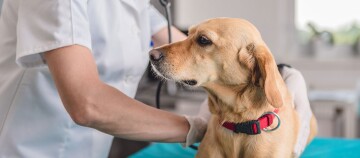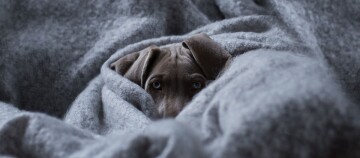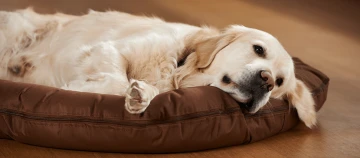Diarrhoea in Dogs – Knowing the Causes and Ensuring Recovery
07.10.2022 - Reading time: 8 minutes
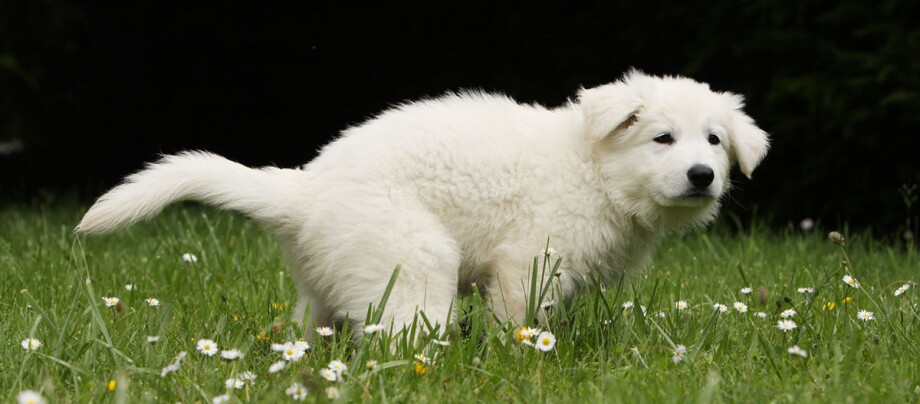
“Oh no, my dog has diarrhoea!” This discovery shocks many dog owners – and rightly so. When your dog has diarrhoea, it is a clear sign of a disturbed gastrointestinal function. The causes for this are very wide-ranging. If the diarrhoea ends quickly, it often suffices to offer a special diet that is gentle on the stomach and intestines, administer appropriate preparations and to ensure rest. Diarrhoea rarely comes alone – many other symptoms may well accompany it. Read here how to best handle your dog’s diarrhoea and learn how to prepare the right diet for his sensitive stomach.
- Diarrhoea in dogs: What exactly is it and what are the causes?
- What can you do if your dog is suffering from acute diarrhoea?
- If the dog has recurrent diarrhoea, what should you do?
- Gentle food for dogs with gastrointestinal problems and diarrhoea
- If my dog already suffers from allergies, what should I do?
- Can you catch diarrhoea from your dog?
Diarrhoea in dogs: What exactly is it and what are the causes?
Diarrhoea refers to the excretion of thin or mushy faeces, known as diarrhoea in medical terms.
Diarrhoea may be accompanied by other gastrointestinal problems, such as abdominal pain, abdominal rumbling or vomiting, and possibly a fever too (higher than 40°C).
If a dog has diarrhoea, it generally lasts from one to three days at most in straightforward cases. During this time, your dog may behave more quietly or seem a bit listless, he may have no appetite or even be lethargic. If the diarrhoea is acute, your dog will have to defecate frequently. You should be prepared for this and take your dog out immediately if you notice any symptoms.
The severity of the symptoms of diarrhoea depend on the individual case. You should monitor your dog for particularly intense symptoms.
The most common causes of diarrhoea in dogs include:
- The wrong food: rotten food, for example carrion, something from the rubbish bin or fresh food (meat, bones) that has been kept for too long or is contaminated with maggots.
- The wrong diet: spicy food, dairy products, incompatible foods such as tomatoes, onions, avocados and many more; poor quality dog food, containing too many carbohydrates and poor proteins, for example.
- Pet food allergies or intolerances: to wheat for example, or to certain types of meat or preservatives.
- Change of diet: for example from dry food to BARF.
- Poisons/harmful substances: poisoned bait, herbicides, fertilisers, animal poisons such as slug pellets, or antifreeze.
- Medication: In some cases, antibiotics or certain painkillers, for instance, may result in diarrhoea as a side effect in dogs.
- Gastrointestinal diseases: Infectious causes such as bacterial or viral gastrointestinal infections, less frequently also fungal infections, intestinal inflammations caused by parasite infestations with worms (helminths) or single-cell organisms (protozoa, e.g. giardia), other intestinal diseases such as chronic inflammatory bowel disease (IBD) without a known cause.
- Other underlying diseases: Pancreatitis, kidney or liver weakness, autoimmune diseases or hormonal diseases. If an underlying disease outside the intestine is the cause of diarrhoea, additional symptoms characteristic of this disease will usually be present.
Please contact the vet or an emergency vet immediately if your dog develops a fever of over 40°C and/or vomits.
Your vet alone has the expertise to examine your dog in order to rule out poisoning, a serious infection or serious organ illness as the cause of the diarrhoea.
My dog has diarrhoea – what should I do?
In the case of acute diarrhoea with no or only mild accompanying symptoms such as a slight fever (max. 40 °C) and if your dog only seems a little quieter than usual, it will initially suffice to keep a close eye on him and to support his natural healing powers.
It is important to provide him with fresh, clean water and try to encourage him to drink. Diarrhoea will cause your dog to lose a lot of fluid, which can lead to dehydration of the body. If your dog loses more fluid than it consumes as a result of the diarrhoea, this can lead to circulatory collapse in extreme cases. Pay attention to your dog’s mucous membranes, for example in the mouth: if they are dry or look pale, you should consult a vet as soon as possible.
Place your poorly four-legged friend on a strict diet and do not give him any food for 24 hours. This should relieve his irritated intestines and prevent them from dehydrating the body and aggravating the diarrhoea. Then prepare special bland food for your pet.
If the general condition worsens or the diarrhoea does not stop after three days, you should see the vet immediately. Puppies with diarrhoea should be taken to the vet on the same day as there is a risk of rapid dehydration, which can be life-threatening.
If the dog has recurrent diarrhoea, what should you do?
Whilst acute diarrhoea in dogs is limited to a few days, a dog can also suffer from chronic diarrhoea: in this case, the symptoms continue over a long period of time. Depending on the cause, it is also possible for a dog to have recurring diarrhoea.
If your dog repeatedly suffers from diarrhoea, you should discuss this with your vet. There could be a number of causes, such as food intolerances, or even organic diseases.
You can assist your vet in making a diagnosis by providing vital information about the symptoms. For example, it would be very useful if you could record the type of food, the feeding time and the times at which the diarrhoea occurs.
In addition, certain indicators can be used to determine the part of the intestine from which your dog’s diarrhoea originates – the small intestine or the large intestine.
For example, differences between small intestinal diarrhoea and large intestinal diarrhoea include:
- Large amounts (small intestine), normal amounts (large intestine)
- Defecation two to three times more often than normal (small intestine), or four to six times more often (large intestine)
- Rare diarrhoea with mucus (small intestine), mucopurulent (a lot of mucus) diarrhoea (large intestine)
- Diarrhoea with blood: red blood mixed with diarrhoea (small intestine), blood is deposited in the faeces (large intestine)
- Contains undigested food components (small intestine), but these are absent in large intestine diarrhoea
Should a dog’s diarrhoea be yellow, the underlying cause may relate to the liver or the pancreas.
Should your dog suffer from recurrent diarrhoea, it may be a good idea to take a faecal sample to the vet. This can be analysed in the laboratory for various pathogens and parasites.
In the case of any of the following symptoms, consult a vet immediately:
- Bloody diarrhoea
- Frequent watery diarrhoea
- Abdominal pain (dog in “prayer position” i.e. lies with chest on the floor, stands on hind legs or assumes other unusual positions)
- Dog is restless
- Dog is lethargic
- Dog does not eat and/or drink
- Dog is vomiting
- Dog has a fever of more than 40°C
How long should I continue to feed a bland diet to treat diarrhoea?
After recovering from or in the case of ongoing diarrhoea, many dogs are left with a damaged intestine and a sensitive stomach.
For this reason, the food you provide for the animal should calm the affected organs and support their healing powers.
Only give your four-legged friend small, easily digestible amounts of food and feed several portions throughout the day. The division of the food ration should relieve the gastrointestinal tract and help with digestion. The length of time your dog needs to be fed a bland diet to treat diarrhoea can vary in each individual case, but after about five days (or a week at the latest) the symptoms should have subsided. As soon as your dog is able to defecate again, you can gradually switch back to its usual diet.
Bland diet formula for a 10kg dog:
- 125 g of chicken meat, cooked until soft and cut into small pieces (white meat without bones!)
- 300 g very soft boiled rice
- 125 g cottage cheese (optional, omit in cases of intolerance)
Since this bland diet does not contain sufficient vitamins and minerals, you will need to start adding dietary supplements after five days.
After the diarrhoea and also during the “fasting period”, you can administer preparations to your dog which provide energy on the one hand (due to the sugar compounds they contain) and on the other hand compensate for the loss of minerals (electrolytes) (e.g. Oralade, Virbac Multi-Elektrolyte). According to the preparation, you can either give this to your dog as a ready-to-use solution or as a powder dissolved in its drinking water. This serves to protect the emaciated dog’s organism from further organ damage. This is especially important for weak or old animals and puppies.
You can buy ready-to-use, bland food for dogs suffering from diarrhoea from your vet and in specialist shops such as the Maxi Zoo online shop, as well as preparations with gut-building ingredients such as prebiotics, probiotics, dietary fibre or tannins. Some dogs benefit from charcoal tablets for diarrhoea which act as toxin binders, i.e. they act as a magnet for toxins. All these remedies work with active ingredients from naturopathy.
Is your dog dependent on certain pet food, due to certain diseases of the organs or diabetes for example, and does he also need to take special medication? Then talk to your vet beforehand.
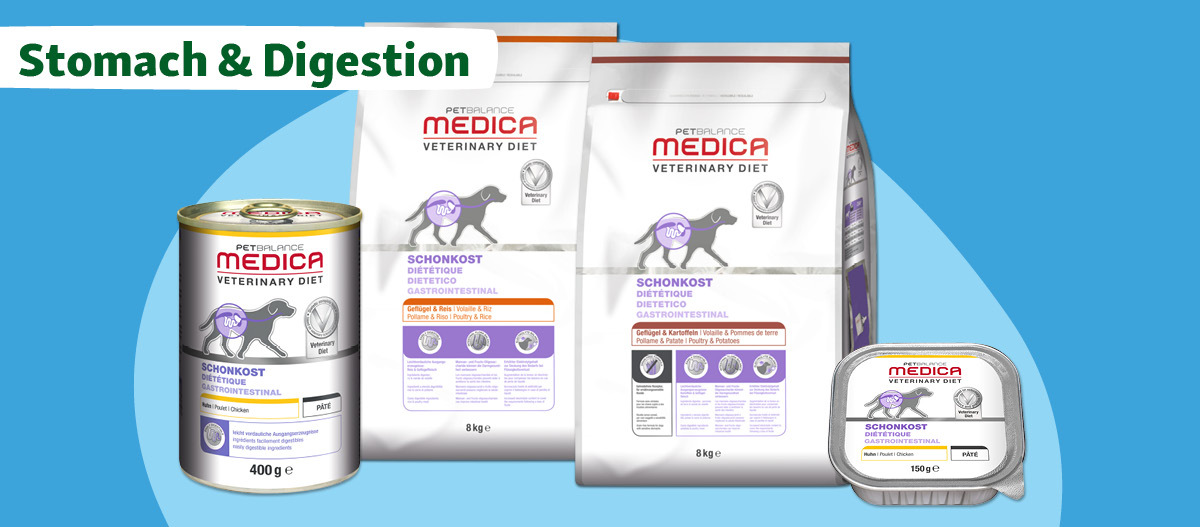
If my dog already suffers from allergies, what should I do?
In the event that your allergic or suspected allergic dog has acute diarrhoea, its risk of allergies will increase due to the disrupted barrier of the intestinal walls.
For this reason, you should provide it with so-called sacrificial protein food for a while after the diarrhoea. This is the name given to allergy food containing only one source of protein that the animal has not had before, for example horse meat or duck. Alternatively, you can give it hydrolysed diet food.
If your dog starts to develop another allergy to this new food, this is not so serious, because after the diet due to diarrhoea you can switch back to the usual allergy food.
Can you catch diarrhoea from your dog?
It is generally advisable to maintain good hygiene when your dog has diarrhoea. This includes careful hand washing after any prolonged contact with the animal, cleaning and disinfecting textiles or surfaces soiled with faeces, and hot rinsing of food and drinking bowls.
Intestinal bacteria can, in principle, make us ill if they enter our bodies through contamination. This can also happen if your dog is healthy.
In addition, there are also bacteria and parasites that cause diarrhoea and that can also be transmitted from dogs to humans. One example is giardia, single-celled parasites that infect the intestines of dogs.
